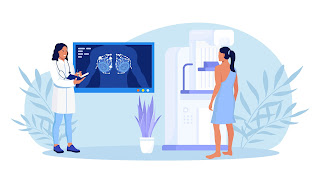Understanding Mammograms
A mammogram is an X-ray of the breast used to detect and diagnose breast diseases. It is recommended for women experiencing breast problems like lumps, pain, or nipple discharge, as well as for those without apparent abnormalities. Mammograms are crucial for early detection of breast cancer.
Importance of Mammograms
Breast cancer is among the most common cancers in women. Mammograms can detect breast cancer up to three years before it can be felt, significantly increasing treatment success rates. By identifying changes in breast tissue, including small cancers not detectable by touch, mammograms save lives.
What Happens During a Mammogram?
During a mammogram, you stand before a specialized X-ray machine. Your breast is placed on a clear plastic plate, and another plate above compresses it briefly to capture clear images. While this may cause discomfort, it ensures accurate results. The process takes about 20 minutes, including images from various angles.
When to Start Having Mammograms
The age to begin mammograms varies based on individual risk factors, particularly family history of breast cancer:
- Average-Risk Women: Start annual mammograms at age 40, as recommended by the American College of Radiology and the Society of Breast Imaging.
- High-Risk Women: Begin annual mammograms and MRI scans at age 30, but no later than 40.
How Often to Have Mammograms Screening frequency depends on age and health status:
- Ages 40-44: Option to start annual mammograms.
- Ages 45-54: Recommended annual mammograms.
- Age 55 and older: Switch to mammograms every two years or continue annually if in good health with a life expectancy of 10 years or more.
When Should You Get a Mammogram
You should typically start considering mammograms as part of routine screening around the age of 40, or earlier if you have a family history of breast cancer or other risk factors. It's generally recommended to have regular mammograms every 1-2 years depending on your age and risk profile. Always consult with your healthcare provider to determine the best screening schedule for you based on your individual health history and risk factors.
The Importance of Regular Mammograms
Regular mammograms are crucial for early breast cancer detection, increasing treatment success rates. They can find lumps before they can be felt, allowing for timely intervention and better outcomes.
Understanding Your Mammogram Results
Mammogram results are interpreted by a radiologist trained to detect breast abnormalities like calcifications or masses. Further testing, such as ultrasound or biopsy, may be recommended for suspicious findings. Not all abnormalities are cancerous.
Preparing for Your Mammogram
Schedule your mammogram when breasts are least tender, usually avoiding the week before menstruation. This reduces discomfort and enhances image quality.
Mammograms and Breast Implants
Women with breast implants can still undergo mammograms with experienced technicians. Inform the facility beforehand for appropriate procedures to visualize breast tissue effectively.
Mammograms for Men
Although rare, men with high breast cancer risk should discuss mammography screening with their doctor.
Conclusion
Mammograms are critical for early breast cancer detection and improved outcomes. Follow guidelines based on individual risk factors and consult with your doctor for personalized screening recommendations. Protect your health with timely screenings and proactive healthcare decisions.


%20Foods%20That%20May%20Ease%20Your%20Pain.jpg)



%20Benefits,%20Nutrition,%20Side%20Effects,%20and%20How%20to%20Use.jpg)
%20Benefits,%20Uses,%20and%20Everything%20You%20Need%20to%20Know%20-%20Healthy%20Roots%20&%20Habits,%20Healthy%20Roots%20&%20Habits%20Blog.jpg)




No comments:
Post a Comment